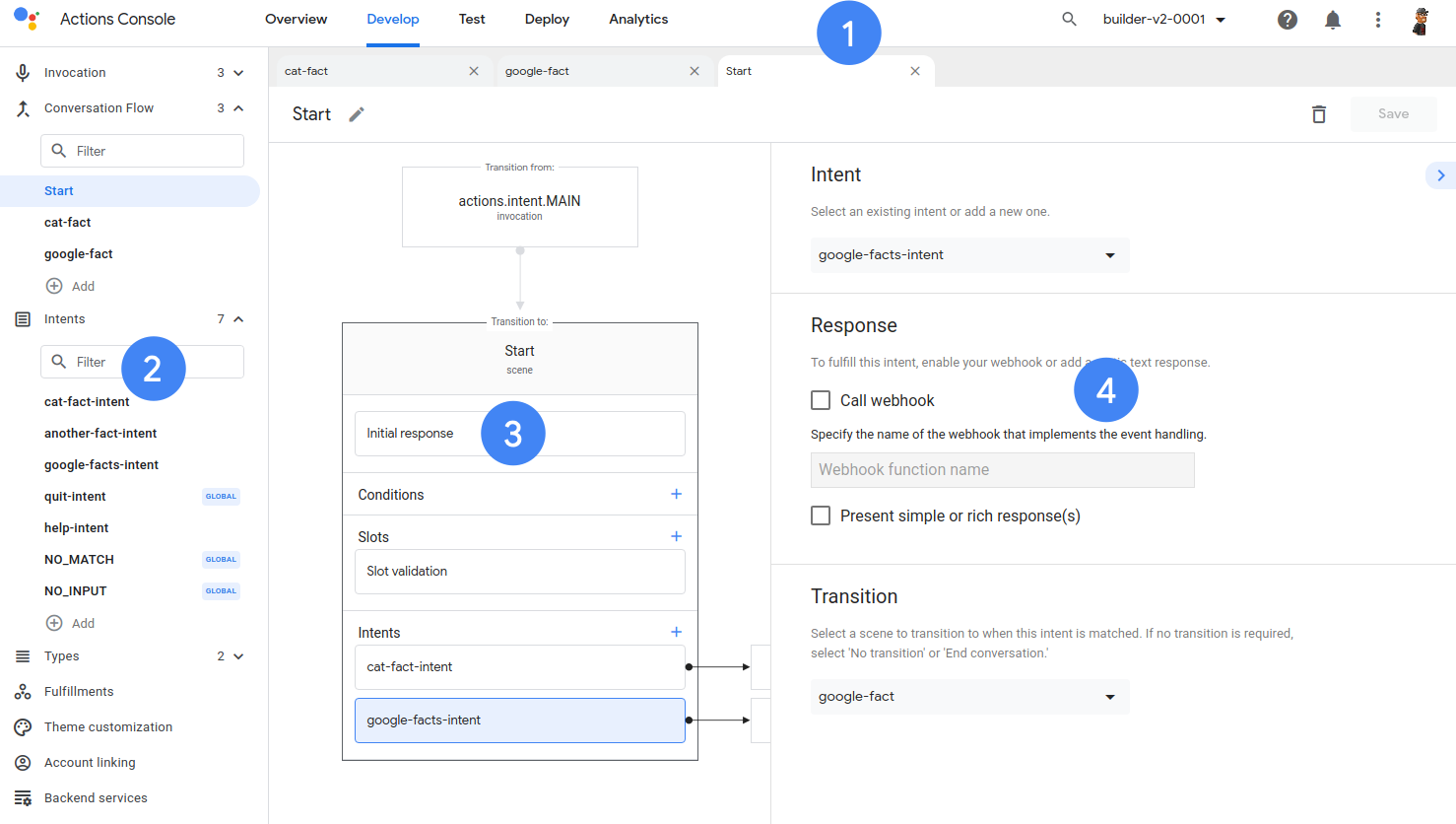会話型アクションをビルドするには、次のコンポーネントを作成してデプロイします。
- Actions プロジェクト - すべての会話型アクション、ウェブサービス、ウェブアプリの論理コンテナ。また、プロジェクトを Actions on Google にデプロイする方法を記述するプロジェクト設定とリソースも定義します。
- 呼び出しモデル - ユーザーがプロジェクト内のアクションを見つけて開始する方法を定義します。呼び出しモデルは、インテントとタイプで構築します。
- 会話モデル - ユーザーがアクションに対して何を言うことができ、アクションがユーザーにどのように応答するかを定義します。会話モデルは、インテント、型、シーン、プロンプトを使用して構築します。
- Webhook - アクションは Webhook をトリガーして、プロンプトの生成やデータの検証などの追加ロジックをフルフィルメント サービスに委任できます。
- Interactive Canvas - 単純なテキスト レスポンスやリッチカードと画像を送信する代わりに、HTML、CSS、JavaScript を使用した全画面表示のインタラクティブなウェブアプリを配信できます。
以降のセクションでは、アクションの作成に使用するツールについて説明します。
操作
Actions API は、Google アシスタント用のアクションを構築するためのデベロッパー ツールのセットです。次の機能で構成されています。
Actions プロジェクトのオープンなファイルベースの表現 - インテント、型、シーン、プロンプトを使用して、呼び出しモデルと会話モデルを構築します。お気に入りのテキスト エディタで Actions プロジェクトを編集したり、ソース管理にチェックインしたり、自動化プロセスを構築したりできます。
コマンドライン インターフェース(CLI)-
gactionsツールは、アクションの開発をブートストラップして自動化するための CLI を提供します。標準の Actions プロジェクト ファイルの初期化、Actions Console へのアップデートのプッシュ、Actions プロジェクトのデプロイなどを行うことができます。このツールを使用すると、既存のプロジェクトのインポートや、お気に入りのソース管理システムを使用した機能ブランチでの作業の開始など、多くの一般的なワークフローを実行できます。Actions API - Actions API は、
gactionsツールで使用される API と同じです。Actions API は、テストやビルドなど、アクションを管理するための REST エンドポイントのリストを提供します。この API を使用すると、JSON リクエストを使用して一般的なワークフローの多くを実行できます。Actions API を使用する際には、考慮すべき制限事項とベスト プラクティスがあります。Webhook と Node.js フルフィルメント ライブラリ - アクションは、Webhook と JSON ベースのメッセージ形式を使用して、ビジネス ロジックをウェブサービスに委任できます。Google では、会話 Webhook の慣用的なインターフェースを提供する Node.js フルフィルメント ライブラリを提供しています。このライブラリを使用すると、一般的なユーザーフローを簡単に実装できます。たとえば、ユーザーのクエリからパラメータを抽出し、Google アシスタントのマルチモーダル エクスペリエンス(音声のみ、音声とビジュアル)を生成する機能などがあります。
アクション ビルダー
Actions Builder は、Actions Console に統合された強力で使いやすいウェブベースの IDE です。Actions Builder は Actions API と同じテクノロジーで構築されているため、ニーズに応じて単独で使用することも、Actions API と組み合わせて使用することもできます。

Actions Builder の UI は次の領域に分かれています。
- 上部メニューから Actions Console のさまざまなエリアにアクセスできます。Actions Builder には [Develop](開発)タブからアクセスできます。
- 左側のメニューから、インテントやシーンなど、アクションの構築に必要なすべてのコンポーネントにアクセスできます。
- ビルド領域では、作業中のコンポーネントをビルドできます。
- 詳細領域では、作業中のコンポーネントの詳細を構成できます。

